Claw toes
Definition
Malformations of the second to the fifth toe are very frequent. We distinguish the proximal interphalangeal (first joint of each toe) and the distal interphalangeal joint ( second joint of each toe) which are at the height of each toe. Both can occur in bending as well as stretching mode.
The malformations are initially smooth and correctable, but as time goes on, they become stiff and not correctable by manipulation.
Symptoms
The burden that the patient mainly experiences by such hammer toes, is the presence of callus-like pavements and/or "corns" on the places where the malformations are in contact with shoes which are too tight, or where overpressure prevails. In this way, toes can also mutually cause friction and wounds. The common place where those symptoms occure are the toe tips or the dorsal aspect of the interphalangeal joints. Some patients cannot wear regular shoes anymore, they need to have shoes with a wide toebox to prevent any pressure between shoe surface and exposed skin parties of the toes.
Causes
As main cause, a certain morphological and static dysharmony at the level of the forefoot should me mentioned, often in combination with hallux valgus and/or metatarsalgia. In addition, less common causes should always be considered, as the treatment will probably be different. We have in mind particularly hammer toes in case of a high arched foot, congenital hammer toes, in case of certain neurological disorders, posttraumatic hammer toes or after severe disturbance of the bloodflow, e.g. in case of compartment syndroma.
Often we find the toe deformities as mentioned above in combination with short achilles tendon or short calf muscle what leads to an overload of the forefoot and to a dysbalance between extending and flexing muscles. We call this overpull of the extensor- muscles of the toes « extensor recruitment phenomenon » which means that the short calf muscles cause as a reaction of lacking dorsalextension in the ankle joint an overpull of the extensor muscles on the frontside. This a frequent cause for dysbalance even in the absence of any neurolgical disorder or trauma.
Medical treatment
In the absence of infection, wounds etc., an insole or the wearing of specific orthotics in silicone (manufactured by the podiatrist) may initially be tried. In all cases we also recommend active training with stretching exercises for the muscles in the foot and also in the lower leg to treat the whole chain of muscles.
This may be helpful especially if the hammer toes are still flexible.
Of course the use of adequate shoewear with a wide toebox is reasonable. In patients with a high potential risk for surgical intervention the production of a custom made orthopedic shoe is a choice to keep the patient mobile and to prevent ulcerations or infections.
Surgical treatment
If, despite all this, the pain and the malformation persist, there are no signs of infection (clinical and radiological) and the blood perfusion allows an operation, a surgical intervent can be scheduled. The different types of surgical corrections mainly depend on the underlying cause:
- Resection of the painful protruding lump (arthroplasty)
- Securing the painful joint, in approximately 15 degrees bending mode (arthrodesis)
- A tendon lengthening
- A tendon transfer
- An osteotomy of the phalanx or the metatarsal bone
In case of a neurological high arched foot, a more complex correction, often in combination with osteotomies and partial joint arthrodesis, need to be done. If not, the deviation will relapse or even worse, the deformity will continue to affect the whole foot.
Post-operative care
Usually, we don’t place a pin, which would be removed during the consultation after 4 weeks. We only do this in specific cases. This removal during the consultation is not painful and somewhat similar to a blood sample. Depending on the kind of surgery that was done, the postoperative course consists of almost immediate partial to full weigth bearing in a special postoperative shoe for 4- 6 weeks.
This surgery can take place in day hospital or in cases of more complex surgery also in combination with a short in hospital stay. Sometimes, a toe remains swollen for 6 to 12 months, and this should not alarm you. It is important, however, to mention it in a follow-up consultation. In almost all cases we see swelling of the toes or the forefoot for at least 3-4 months.




